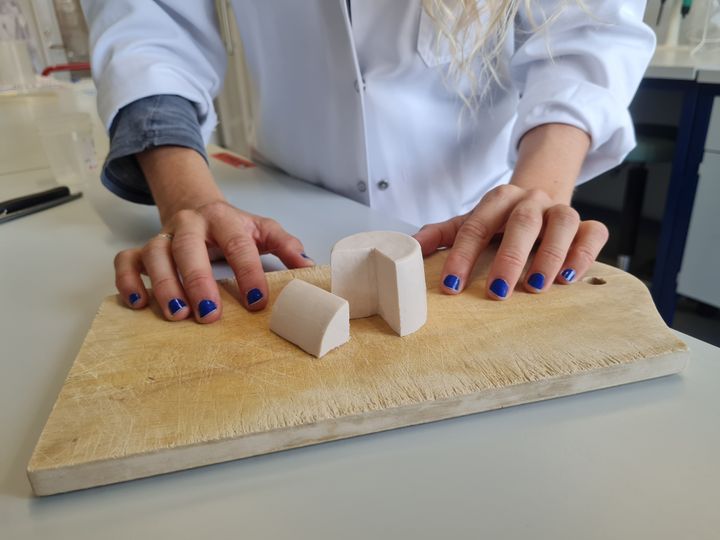Ancient technology turns plant-based cheese into 'something we want to eat'
To produce plant-based cheeses that feel and taste like dairy cheese, scientists have their sights set on fermentation. In a new research result, University of Copenhagen scientists demonstrate the potential of fermentation for producing climate-friendly cheeses that people want to eat.

Nearly thirty kilos of cheese are eaten by the average dairy-loving Dane every year. But increasing pressure on Earth's resources and climate change call for our food system to turn in a more plant-based direction. As a result, scientists are looking into how to transform protein-rich plants like peas and beans into a new generation of non-dairy cheeses that possess the similar sensory properties as the dairy-based ones that humans have enjoyed for thousands of years.
Several plant-based cheeses are already on the market. The challenge is that plant proteins behave differently than milk proteins when trying to make cheese from them. To meet this challenge, producers add starch or coconut oil to harden plant cheeses, as well as an array of flavourants to make them taste like cheese.
But it turns out that this can be done with the help of nature’s smallest creatures. In a new research result from the University of Copenhagen’s Department of Food Science, researcher Carmen Masiá has succeeded in developing plant-based cheeses made from yellow pea protein with a firm texture and improved aroma profile. She was able to do so by using the same natural fermentation process with bacteria that we have used with cheeses made from milk for thousands of years.
"Fermentation is an incredibly powerful tool to develop flavour and texture in plant-based cheeses. In this study, we show that bacteria can serve to develop firmness in non-dairy cheese in a very short period of time while reducing the bean-like aroma of yellow pea protein, which is used as the main and only protein source," explains Carmen Masiá.
Fresh cheese after eight hours
The result builds upon a research result from last year by the same researcher, who found that yellow pea protein constituted a good "protein base" for making fermented plant-based cheese. In the new result, the researcher examined twenty four bacterial combinations made from bacterial cultures supplied by the biotech company Chr. Hansen, where Carmen Masiá is completing her Industrial PhD.
"The whole point of this study has been to combine the commercially-available bacterial cultures that are suitable for the fermentation of a plant-based raw material, and test them in a pea protein matrix to develop both taste and texture that would be suitable for a cheese-like product. And, even if some bacterial combinations performed better than others, all of them actually provided firm gels and reduced beaniness in the samples" says the researcher.
To study the behavior of the bacterial combinations, the scientist inoculated them in a protein base made of yellow pea protein. After only eight hours of incubation, the result was a firm "cheese-like gel" reminiscent of a fresh soft white cheese.
"All bacterial blends produced firm gels, which means that one can get a fermentation-induced gel without necessarily adding starch or coconut oil to the base. From an aroma perspective, we had two goals: To reduce the compounds that characterize the beaniness of yellow peas, and to produce compounds that are normally found in dairy cheese. Here we saw that some bacteria were better at producing certain volatile compounds than others, but that they all worked great to reduce beaniness – which is a very positive outcome. Furthermore, all blends acquired dairy aroma notes to different degrees" explains Carmen Masiá.
What is fermentation
Fermentation is an ancient technique which originated in China. Today, it is used to make beer, wine, cheese, pharmaceuticals and much more. Fermented foods are preserved by initiating a fermentation process in which natural lactic acid bacteria and enzymes are formed. This is done as microorganisms convert sugars in the selected food into lactic acid, acetic acid and carbon dioxide. This makes food acidic and prevents the growth of putrefactive and pathogenic bacteria.
The first textual evidence of cabbage fermentation is found in China's oldest collection of poems, Shi Jing (Book of the Odes), which dates back to approximately 600 BC.
Sensory is everything
The researcher points out there is still a way to go to before achieving this plant-based cheese, but that research is on the right track. According to her, tailored bacterial compositions and cultures must be developed in order to achieve the optimal cheese-like characteristics. Furthermore, the plant-based cheese might need to mature over time so that it develops flavor and character, just as dairy-based cheeses do.
Finally, the new generation of fermented plant-based cheeses must be judged by consumers, so that the flavour is perfected. All in all, this is to make plant-based cheeses so delicious that people seek them out and purchase them.
"The most challenging thing for now is that, while there are a lot of people who would like to eat plant-based cheese, they aren’t satisfied with how it tastes and feels in the mouth. In the end, this means that no matter how sustainable, nutritious, etc. a food product is, people aren't interested in buying it if it doesn't provide a good experience when consumed," says Carmen Masiá, who adds:
"One needs to remember that dairy cheese production has been studied over many years, so it's not something that we can just mimic overnight with totally different raw materials. Nevertheless, there are many scientists and companies out there doing great progress in the field; I hope that we will get closer to making non-dairy cheeses that taste good over the next few years. We are getting there."
The study was conducted in collaboration between the Department of Food Science and microbial ingredients supplier Chr. Hansen, a bioscience company that produces ingredients for the food and pharmaceutical industries, among other things.
About the study:
- The researchers tested twenty four different bacterial compositions on a protein base made from yellow pea protein.
- The study shows that all of the bacterial compositions produce a firm cheese-like gel, reduced the beaniness, and produced dairy-related volatile compounds.
- The study was conducted in collaboration between the Department of Food Science and microbial ingredients supplier Chr. Hansen, a bioscience company that manufactures microbial ingredients for the food and pharmaceutical industries.
- The study has been published in the scientific journal Future Foods
- The research is funded by Innovation Fund Denmark (grant 0153-00058B)
Contact
Carmen Masiá
Industrial PhD
Department of Food Science
University of Copenhagen
Mail: cala@food.ku.dk / dkcamc@chr-hansen.com
Michael Skov Jensen
Journalist & team coordinator
The Faculty of Science
University of Copenhagen
Mobile: +45 93 56 58 97
msj@science.ku.dk
Følg pressemeddelelser fra Københavns Universitet - Det Natur- og Biovidenskabelige Fakultet
Skriv dig op her, og modtag pressemeddelelser på e-mail. Indtast din e-mail, klik på abonner, og følg instruktionerne i den udsendte e-mail.
Flere pressemeddelelser fra Københavns Universitet - Det Natur- og Biovidenskabelige Fakultet
Saving the Asian Unicorn – If It Still Exists6.5.2025 09:48:24 CEST | Press release
The saola, an antelope-like bovine, is one of the world’s rarest and most endangered mammals. In fact, it hasn’t been observed in over 10 years. Researchers from the University of Copenhagen, in collaboration with Vietnamese scientists and an international team of researchers, have for the first time mapped the saola’s complete genome, and they have used that knowledge to estimate the chances of saving it – if it still exists.
Sådan redder vi den asiatiske enhjørning – hvis den altså findes6.5.2025 07:07:00 CEST | Pressemeddelelse
Den antilopeagtige okse, saolaen, er et af verdens mest sjældne og mest truede pattedyr – faktisk er den ikke blevet set i over 10 år. Forskere fra Københavns Universitet har i samarbejde med vietnamesiske forskere som de første kortlagt saolaens gener, og den viden har de brugt til at beregne sandsynligheden for, at vi kan nå at redde den – hvis den altså stadig findes.
Saving the Asian Unicorn – If It Still Exists5.5.2025 17:00:00 CEST | Press release
The saola, an antelope-like bovine, is one of the world’s rarest and most endangered mammals. In fact, it hasn’t been observed in over 10 years. Researchers from the University of Copenhagen, in collaboration with Vietnamese scientists and an international team of researchers, have for the first time mapped the saola’s complete genome, and they have used that knowledge to estimate the chances of saving it – if it still exists.
Bakterier bruger gammelt krigstrick til at overliste vira: Kan hjælpe med at bekæmpe ’superbugs’30.4.2025 07:30:00 CEST | Pressemeddelelse
Forskere har opdaget en ny type immunforsvar i coli-bakterier, der vender en virusinfektion mod vira selv. Systemet er opkaldt efter den kinesiske militærstrateg Kongming som var berømt for at bruge fjendens våben til at besejre dem. Opdagelsen kan bruges i udviklingen af fremtidige bioteknologiske værktøjer og måske som et alternativ til antibiotika til at bekæmpe multiresistente bakterier.
Nyt forskeruddannelsesprogram skal udklække fremtidens kvantespecialister29.4.2025 10:24:11 CEST | Pressemeddelelse
Med støtte fra Villum Fonden opretter Københavns Universitet og DTU et nyt forskeruddannelsesprogram, der skal være med til at sikre, at Danmark kan bevare sin styrkeposition inden for kvanteforskning i fremtiden.
I vores nyhedsrum kan du læse alle vores pressemeddelelser, tilgå materiale i form af billeder og dokumenter samt finde vores kontaktoplysninger.
Besøg vores nyhedsrum